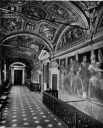For many centuries dominating the commercial exchanges in
the Mediterranean (in antagonism with the Republic of Venice) also
thanks to the creation of numerous colonies in oriental lands , the  Republic of Genoa has, with alternate vicissitudes, seen growing up power and prestige, testified from
the birth of one of the first
banking institutions in the world (Banco of S.Giorgio) from the adoption of new
commercial contracts and from "la Superba" name given to the city.
Republic of Genoa has, with alternate vicissitudes, seen growing up power and prestige, testified from
the birth of one of the first
banking institutions in the world (Banco of S.Giorgio) from the adoption of new
commercial contracts and from "la Superba" name given to the city.
Genoa, whose first written
testimonies go back to the 218 a.C., has been developed above all in
medieval age arriving to having what it has been and it is still now
the biggest historical center (medieval) of Europe. Most numerous noble palaces rich
 decorated, testify the power of the genovesi and
of Ligurian families (Doria, Grimaldi, Fieschi, Spinola) and equally
the numerous decorated, testify the power of the genovesi and
of Ligurian families (Doria, Grimaldi, Fieschi, Spinola) and equally
the numerous churches (from the typical coloration to bands black
and white) show the devotion of its inhabitants. Numerous the
wars that those places have seen in the centuries; the
whose memory is still visible in the powerful and very long boundary wall that encircles the city. churches (from the typical coloration to bands black
and white) show the devotion of its inhabitants. Numerous the
wars that those places have seen in the centuries; the
whose memory is still visible in the powerful and very long boundary wall that encircles the city.
The Liguria has an indended coast that donates
foreshortenings  of rare beauty; in many of
them the
typical Ligurian houses that were developed in height (because of
the sparsity of space) and rich colored (for being able to be seen from the sea) have created villages of fishermen who
survive still today with old beauty (Portofino, Camogli, Sestri Levante, the
Cinque Terre, Porto Venere and many others). of rare beauty; in many of
them the
typical Ligurian houses that were developed in height (because of
the sparsity of space) and rich colored (for being able to be seen from the sea) have created villages of fishermen who
survive still today with old beauty (Portofino, Camogli, Sestri Levante, the
Cinque Terre, Porto Venere and many others).
 The
Ligurian gastronomy is rich of simple and genuine
ingredients; Pesto is the most famous (made up of sauce basil whose scent
assumes alone in this earth a particular fragrance), the olive oil,
the white wine that constitute the base for the preparation
of delicious local recipes. The
Ligurian gastronomy is rich of simple and genuine
ingredients; Pesto is the most famous (made up of sauce basil whose scent
assumes alone in this earth a particular fragrance), the olive oil,
the white wine that constitute the base for the preparation
of delicious local recipes.
|